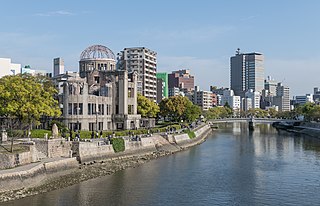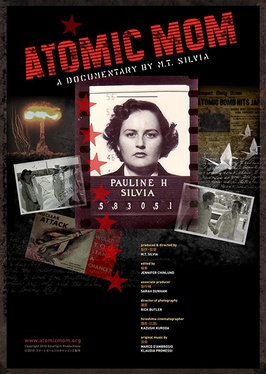Related Research Articles

Hiroshima is the capital of Hiroshima Prefecture in Japan. As of June 1, 2019, the city had an estimated population of 1,199,391. The gross domestic product (GDP) in Greater Hiroshima, Hiroshima Urban Employment Area, was US$61.3 billion as of 2010. Kazumi Matsui has been the city's mayor since April 2011. The Hiroshima metropolitan area is the second largest urban area in the Chugoku Region of Japan, following the Okayama metropolitan area.

Sadako Sasaki was a Japanese girl who became a victim of the atomic bombings of Hiroshima and Nagasaki by the United States. She was two years of age when the bombs were dropped and was severely irradiated. She survived for another ten years, becoming one of the most widely known hibakusha—a Japanese term meaning "bomb-affected person". She is remembered through the story of the more than one thousand origami cranes she folded before her death. She died at the age of 12 on October 25, 1955, at the Hiroshima Red Cross Hospital.

Hibakusha is a word of Japanese origin generally designating the people affected by the atomic bombings of Hiroshima and Nagasaki by the United States at the end of World War II.
Hiroshima Witness, also released as Voice of Hibakusha, is a documentary film featuring 100 interviews of people who survived the atomic bombings of Hiroshima and Nagasaki, also known as hibakusha. Hiroshima Witness was produced in 1986 by the Hiroshima Peace Cultural Center and NHK, the public broadcasting company of Japan.

Hiroshima Peace Memorial Park is a memorial park in the center of Hiroshima, Japan. It is dedicated to the legacy of Hiroshima as the first city in the world to suffer a nuclear attack at the end of World War II, and to the memories of the bomb's direct and indirect victims. The Hiroshima Peace Memorial Park is visited by more than one million people each year. The park is there in memory of the victims of the nuclear attack on August 6, 1945, in which the United States dropped an atomic bomb on the Japanese city of Hiroshima. The Hiroshima Peace Memorial Park was planned and designed by the Japanese Architect Kenzō Tange at Tange Lab.

The Hiroshima Peace Memorial Museum is a museum located in Hiroshima Peace Memorial Park, in central Hiroshima, Japan, dedicated to documenting the atomic bombing of Hiroshima in World War II.

Steven Toll Okazaki is an American documentary filmmaker known for his raw, cinéma vérité-style documentaries that frequently show ordinary people dealing with extraordinary circumstances. He has received a Peabody Award, a Primetime Emmy and has been nominated for four Academy Awards, winning an Oscar for the documentary short subject, Days of Waiting: The Life & Art of Estelle Ishigo.

On August 6 and 9, 1945, the United States detonated two atomic bombs over the Japanese cities of Hiroshima and Nagasaki, respectively. The bombings killed between 150,000 and 246,000 people, most of whom were civilians, and remain the only use of nuclear weapons in an armed conflict. Japan surrendered to the Allies on August 15, six days after the bombing of Nagasaki and the Soviet Union's declaration of war against Japan and invasion of Japanese-occupied Manchuria. The Japanese government signed the instrument of surrender on 2 September, effectively ending the war.

White Light/Black Rain: The Destruction of Hiroshima and Nagasaki is an HBO documentary film directed and produced by Steven Okazaki. It was released on August 6, 2007, on HBO, marking the 62nd anniversary of the first atomic bombing. The film features interviews with fourteen Japanese survivors and four Americans involved in the 1945 atomic bombings of Hiroshima and Nagasaki.

Sumiteru Taniguchi was a Japanese anti-nuclear activist and survivor of the 1945 atomic bombing of Nagasaki, who was chairman of the Nagasaki Council of A-Bomb Sufferers.
This is a list of cultural products made about the atomic bombings of Hiroshima and Nagasaki. It includes literature, film, music and other art forms.

Tsutomu Yamaguchi was a Japanese marine engineer who survived both the Hiroshima and Nagasaki atomic bombings during World War II. Although at least 160 people are known to have been affected by both bombings, he is the only person to have been officially recognized by the government of Japan as surviving both explosions.

Barbara Leonard Reynolds, was an American author who became a Quaker, peace activist and educator.

Hiroshima is a BBC docudrama that premiered as a television special on 5 August 2005, marking the eve of the 60th anniversary of the atomic bombing of Hiroshima. The program was aired on the Discovery Channel and BBC America in the United States. The documentary features historical reenactments using firsthand eyewitness accounts and computer-generated imagery of the explosion. The film won an Emmy and three BAFTA awards in 2006.

Hibakusha is a 2012 American animated short film directed by Steve Nguyen and Choz Belen, and produced by Iconic Films, the Documentary Channel (USA), and Studio APA in Los Angeles, California, and New York City, New York.
War and Peace is a 2002 Indian documentary film directed by Anand Patwardhan. The film covers the Indian and Pakistani nuclear weapons tests in 1998, as well as the nationalist rhetoric that accompanied these tests. It also explores the ill-effects of the Indian test on the surrounding population and the reactions to the test among the government and the public. The latter part of the film also covers the perception of nuclear weapons in Japan and the United States. Upon the film's completion, the Indian censor board demanded that Patwardhan make 21 cuts before it could be released, including cutting all speeches by politicians. Patwardhan refused and took the matter to court; the Bombay high court ruled in his favour a year later, and the film was released without any cuts.

Atomic Mom is a 2010 documentary film written and directed by M.T. Silvia about the complex experiences of two women struggling with the emotional repercussions of their connections to the nuclear bombings on Hiroshima, Japan, at the end of World War II in August 1945.
The Japan Confederation of A- and H-Bomb Sufferers Organizations, often shortened to Nihon Hidankyō, is a group that represents survivors of the atomic bombings of Hiroshima and Nagasaki. It was formed in 1956.
Martin Duckworth is a Canadian documentary director and cinematographer who was on staff at the National Film Board from 1963 to 1970 and has continued to work with them as a freelance filmmaker. He was cinematographer on more than 100 films, and directed or co-directed 30, most of them with the NFB.

Setsuko Thurlow, born Setsuko Nakamura, is a Japanese–Canadian nuclear disarmament campaigner and Hibakusha who survived the atomic bombing of Hiroshima on 6 August 1945. She is mostly known throughout the world for being a leading figure of the International Campaign to Abolish Nuclear weapons (ICAN) and to have given the acceptance speech for its reception of the 2017 Nobel peace prize.
References
- ↑ "No More Hiroshima". Collection. National Film Board of Canada. 1984. Retrieved 20 October 2009.
- ↑ Dubrofsky, Susan. "Interview with Martin Duckworth, documentary filmmaker". Montreal Serai. Archived from the original on 4 March 2016. Retrieved 6 August 2012.